ArkPak Portable Power When and Where You Need It – Product Review
Tim Esterdahl | Dec 30, 2013 | Comments 14
For many outdoor enthusiasts, portable power is a pain point. You can invest in a gas-powered generator to run campsite accessories, etc., but that’s a loud and expensive way to go. You can also plug things into your vehicle, but that only works if you don’t have much to plugin. You wouldn’t want to leave a camp fridge plugged into your vehicle all day long without fearing a dead battery.
If you’re interested in a power source for a campsite (or for tailgating) that offers more than just plugging into your car – but that doesn’t require the investment or hassle of a real generator – read on.
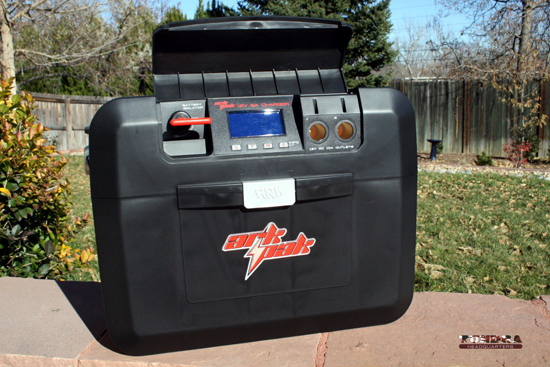
The ArkPak provides portable power when and where you need it. It is a pretty cool piece of equipment for campers, tailgaters, and could even serve as a power source in a home emergency.
The ArkPak (available here) is a portable power source that has many different uses. Essentially, it’s a battery in a box that also includes a high-speed charger, an inverter, and a variety of power connection options. It can be used as a power source at a camp site, installed into a vehicle to act as a dual battery, and of course it can be used to jump-start a dead battery.
First, A Little Bit About Ark
The company that makes the ArkPak is the Ark Corporation, and they’re a big manufacturer of trailer parts and equipment in Australia. The ArkPak has been available for sale in Australia for a couple of years, and the device is evidently quite popular with people who camp in Australia’s bush. It’s only recently been made available in the US and Canada.
They gave TundraHQ a unit to test and review, which brings you up to speed.
Initial Setup and Charging
When the ArkPak arrived at my door, it did not include a battery (none of them do – it’s a feature – read on). I installed a 93ah deep-cycle marine battery (procured at my local Wal-Mart for $110, including core fee) by dropping it into the box, tightening the battery strap, and then connecting the positive and negative terminals to the provided cables.
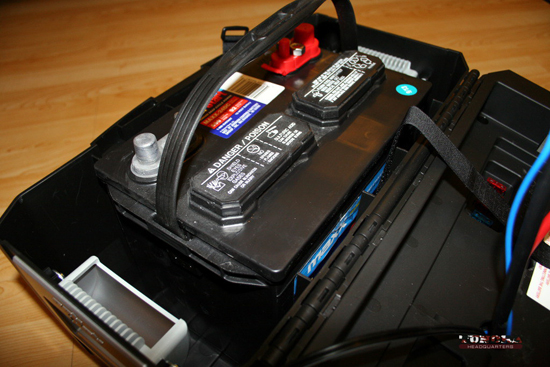
Just pop in a marine battery, charge it and you are ready to go.
Upon activating the box, a small instrument panel lights up and a cooling/ventilating fan comes on (the fan isn’t too loud, but it is noticeable in my otherwise silent garage). The instrument panel displays the battery charge left with a calculated time left on the battery. The new battery I purchased was listed at 93%.
NOTE: When you buy a new car battery at Wal-Mart (or anywhere else), don’t be bashful about asking for a voltage test. Battery voltage indicates how long a battery has been sitting on the shelf, and you want to buy a standard automotive battery that’s at or above 12.5V if possible. Once a battery falls below 12.5V, it’s likely been discharged more than 20%. Standard car batteries don’t necessarily come all the way back once they’ve been discharged more than 25%.
If you’re buying a deep-cycle battery, you can tolerate voltage as low as 12V. The battery I bought for the ArkPak tested at a little over 14V.
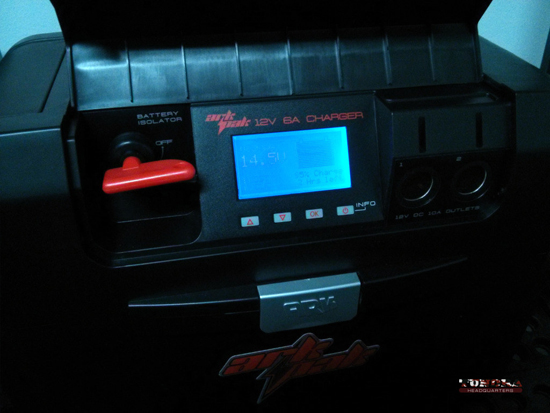
The instrument panel on the ArkPak.
Once you install a battery, it’s time to plugin your ArkPak. The reason? Lead-acid batteries drain themselves over time. If you want to maintain your battery’s performance, it needs to be plugged into the wall (or your car) and charging. The ArkPak came with both a standard 120VAC wall charger as well as a 12V car charger, but since I don’t want to haul around any more weight than necessary, I opted to plug into the wall.
The ArkPak has a sophisticated charging circuit that’s designed to both maximize the lifespan of your battery as well as charge it quickly. If you buy one of these things, be sure to consult the manual about all the different charging modes the unit has…the listed modes (Charge, Testing, Bulk, Boost, Resting, Float, and Re-awaken) are all pretty obvious, but the manual is worth reviewing nonetheless. My battery was fully charged in about an hour.
NOTE: If you want to charge the ArkPak with a solar panel (something I’m planning on trying a little later this month), you’ll need to buy a panel with an integrated charge controller specifically designed for charging lead acid batteries from a solar panel (they’re readily available on Amazon.com). The built-in charging system isn’t compatible with a solar panel.
Testing it Out
Once my battery was rated at 100%, I decided to run a little experiment. My laptop’s built-in battery is officially toast…it dies in about 20 minutes. Therefore, I always need to be plugged into the wall. This means I can’t easily use my laptop in a couple of my favorite spots around the house (both in the backyard). So, I lugged the ArkPak outside (it’s not at all heavy by itself, but the marine battery inside it makes it weigh about 65lbs, give or take), parked it under a tree next to a lawnchair, plugged in my laptop, and enjoyed one of Colorado’s famously sunny and warm December days (NOTE: I wrote this a few weeks ago before a nasty cold snap hit). The laptop had no trouble getting power from the ArkPak, and after a couple of hours of work, the ArkPak showed that I had about 85% battery life left.
Doing the math, this rating makes sense:
- The battery I installed was rated at 93ah. If we assume that rating is at 12V, than my 90W laptop used about 15ah during my two hours of outdoor laptop-ing.
- 15% of my 93ah rating is 13.95ah
If I’m willing to discharge my battery down to 50% (and I am – deep cycle batteries are OK to discharge 50% over and over again), than I’d probably be able to use my 90W laptop for 6 hours. I think this estimate is low, as the battery is brand new (it will perform better with some age), and I doubt my laptop pulls the full 90W. If I were using this to power my laptop to watch a movie in my tent, for example, I could turn down the brightness of the display and probably milk a lot more use time out of the battery.
The box that the ArkPak comes in lists a handful of devices and how long the ArkPak can power these devices before going dead. While I think these numbers are all misleading (they assume 100% battery discharge, something I would never do on purpose), they’re interesting nonetheless. If you cut them all in half (50% discharge), you’re much closer to what I would suggest.
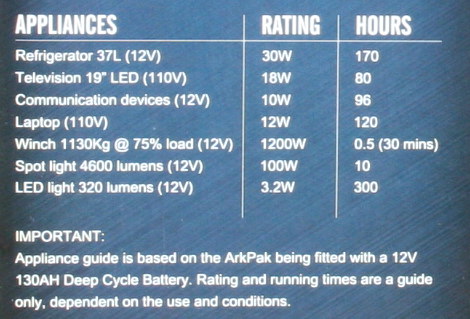
The stated ratings for various appliances, assuming a 130ah battery that’s fully discharged.
Observations and Notes
1) Where’s the battery?
When the unit arrived without a battery, I was perplexed. “Where’s the beef?,” I asked. I was told that this is a key feature the ArkPak has over competing units.
Goal Zero, for example, sells a box they call the “23000 Yeti 400 Solar Generator” that’s basically the same as the ArkPak, but that costs a little more ($450 on Amazon) and includes a battery…but the battery is only rated at 33ah! While the ArkPak + WalMart battery costs more ($510 as tested), it’s got 3 times as much power (93ah vs 33ah). Additionally, Ark told me that I can find a 130ah battery that will fit inside the ArkPak online.
So, basically, the lack of a battery means you can put whatever you want inside the unit. It’s a good thing.
2) Can I build my own ArkPak for less?
Looking online for other reviews of this box, I found a couple forum posters who argued that they could build their own “ArkPak” for a fraction of the cost. Basically, these posters argued that you can buy a battery box, an inverter, and a charger for less than $399, and then bolt it all together and call it good. I ran this idea by Ark (the company that makes the ArkPak) and they offered these counter-points:
- A home-made ArkPak isn’t going to have the same sophisticated charging system. This, according to Ark, is the key difference between their device and most other devices. Your typical battery charger (like the one found at your local big box store for $25) only pushes 500-750ma. The ArkPak’s charger is rated at 6A. What’s more, Ark says their smart charger is actually much “smarter” than the chargers you can buy at the store.
- The ArkPak has been heavily tested and is known to be reliable. If your home-made ArkPak were to fail out in the middle of the woods, it doesn’t save you much money at all.
I priced out my own home-made unit just for giggles, and while the total price of my own unit would undoubtedly be lower than the price of the ArkPak, I couldn’t find a charger that matched the ArkPak’s 6A rating. I also couldn’t find a battery box that included all the different power options…I’d have to spend a good amount of time and effort to build something comparable. Considering my interest in building my own portable battery box (very low, for the record), I’d say it’s a misnomer. You could build a comparable unit for less, but not much less…and definitely comparable in only a very loose sense.
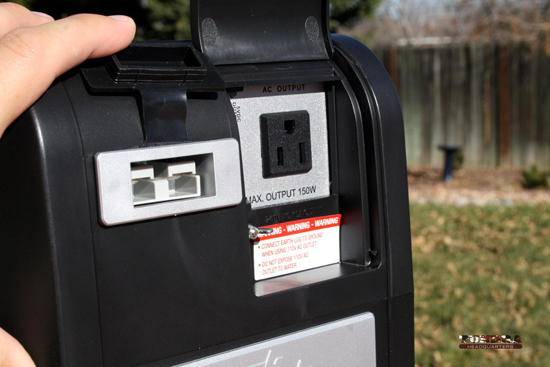
The ArkPak has quite a few different connection options, but the most valuable to campers will probably be the 12V cigarette lighter outlets and the USB ports.
3) What’s with the 150W inverter?
I appreciate that everyone always wants more – more battery capacity, more power, etc. – but the 150W inverter rating seems low to me. The Goal Zero Yeti 400 (linked to above) has a 300W inverter. Looking around the house, I had a hard time finding things that would run on 150W. While most of my camping gear has a 12V plug (and therefore doesn’t need the inverter), it’s a bit of a disappointment that the ArkPak doesn’t come with a bigger inverter.
4) The Goal Zero is prettier.
For giggles, I went to my local REI (a place I shop at but never buy at) to take a peak at the Goal Zero product line. While the ArkPak definitely seems like a better value to me, there’s no disputing that the packaging for a Goal Zero box is nicer, and the units look more sophisticated.
To be clear, I’m not saying that I like the Goal Zero better (I do not – they seem incredibly over-priced when you consider the battery ratings). However, the fit and finish of the ArkPak’s plastic case is poor in comparison, and the device doesn’t “feel” as nice. Ark would do well to raise their game here.
5) Can I use it as an emergency power source at home?
Sort of. I couldn’t plug anything substantial into the ArkPak because of the low wattage rating on the inverter. However, if we lost power, I could use it to keep cell phones charged for a long time (perhaps weeks if I only used my cell phone sparingly). When I hook up the solar panel I bought to try out with this box (you can read more about that on TacomaHQ in the coming weeks), I might have a different opinion.
Suffice to say, this box is primarily designed to be a portable power source for camping, hunting, etc.
Our Take
If you want to power a camp site, this device is just about perfect. It’s relatively portable, seemingly durable, and most importantly you really don’t care if you run the battery down on the ArkPak powering your devices. If you run the battery down on your truck (something I did once while camping in my younger days), you need another vehicle owner to give you a jump.
The ArkPak can also be used to run small electronic devices for a few hours (or longer, if we’re talking about an iPad or phone), which makes it an interesting emergency power source just in case. While it’s no substitute for a gas or diesel generator, it’s better than nothing.
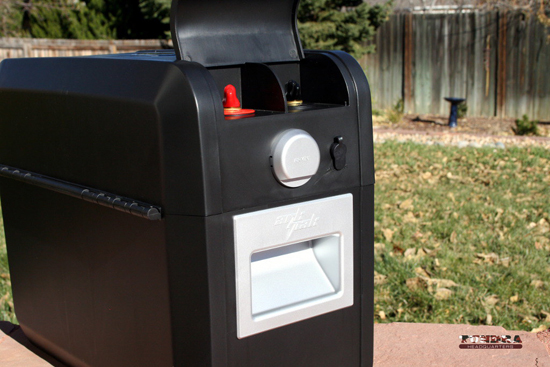
The large carry handles are great as are the many different power outlet options.
However, it strikes us as most useful for campers, tailgaters, etc. We don’t have a small TV to test it with, but it seems like it would be great for watching TV in the back of your truck while tailgating. The state of Illinois or "The Land of Lincoln" is the fifth most populated state in the United States. It is known for some of the inventions that are part of everyday use such as the first-ever dishwasher, the first wireless remote control to use a TV, and much more. This state is home to thousands of students from across the globe. College life brings in-house parties, barn dances, and intriguing drinking bars. The minors use Illinois IDs in apartments, houses, or campuses for celebrating a small birthday bash party or a fraternity gathering for an occasion like Halloween.
Pricing and Recommendation
While one could consider a portable power source as an invaluable when you really really need it, the asking price for the ArkPak is $399 (opens in a new window). That includes the box, the car charger, the wall charger, and some mounting brackets. The $399 asking price does NOT include a deep-cycle marine or RV battery.
When you consider the cost of the similar Goal Zero products, the ArkPak is a very good deal. Quite frankly, anyone who pays $450 for a “Yeti 400” (or a whopping $1,000+ for a “Yeti 1250”) is a sucker. This device is a much better value.
Still, this device isn’t for everyone. If you don’t bring a lot of electrical devices with you when you go camping or hunting or whatever, you probably don’t have much use for this device.
Thoughts? Comments? The folks at Ark have promised to read all our comments and respond as necessary.
Filed Under: TundraHeadquarters.com


OK Tim ……
I have an old Black and Decker Electromate 400 which does basically all the same things as the ArkPak and only cost $90 at the B&D store. Granted it doesn’t have a 93ah battery, but it doesn’t weigh anywhere near 65 lbs either! (more like 15) I guess it depends on what you need.
Mendonsy,
Right. It all depends on what you need.
-Tim
You already have a vehicle with a battery, and probably have a battery charger. You can find a 300W invertor on Ebay for less than $25 shipped. Now that you have saved $375, you could spend $300 of it on a 3000W portable generator, and have a real emergency backup power. Spend the remaining $75 on beer and you and your friends can get drunk and laugh at the people who wasted $399 on this POS.
Tonyspin,
LOL! I don’t know that I would go so far to say it is a POS, it has its valid points. For the camper, who wants a tested, reliable system, it makes sense to us.
However, there are those that want to build their own unit and that is fine. To each their own.
-Tim
Maybe I shouldn’t say POS, but it really is overpriced for the capability it affords. This unit is really just for light power needs and a $25 300W invertor plugged into your vehicles 12V power outlet will give you twice the power than this unit will. You would be hard pressed to run a campsite on this unit, unless you just want to charge your phone or computer, and maybe have a light bulb or 2. My point is this: don’t waste your money on this unit. Spend much less on an invertor and a generator and have 20X the power, more capability and much more versatility.
tonyspin – I think you’re missing one of the key benefits. If you’re plugging all your gear into your truck, you’re going to kill your battery eventually.
If you’re camping one night and planning on making a couple of cups of coffee with a camping coffee maker in the morning, your car is fine. If you’re doing that for the whole gang at deer camp, you’re going to want to start and run your truck for a while.
I’m not saying you’re wrong, but there’s more to this device than just 12V power. It’s separate from your car, the capacity is good, etc. People *love* the Goal Zero units this competes with, for example, and a lot of them are using these boxes to go “off the grid” for extended periods.
I just think it is a lot of money to spend for convenience. Make it yourself for less than $100. Add a deep cell for another $100. Add a 3000W generator for $300. Now you have real capability and backup for $500.
I too would not call this system a POS, I have built many of these and use them on river trips. We place the batteries in steel ammo boxes or water proof pelican cases. Great care must be taken with a steel box to guaranty the terminals can never come in contact with the steel. We do use bigger inverters so we can run some power tools.
I like the look of this systems since it has all the sockets ready to go.
Looks like a good device for most people who want spare power for road trips. I would agree 400 seems a bit much and for the do it yourself crowd there are a lot of options. Make your own or spend 400 either way it’s worth having.
I agree Tim it does have valid points. It’s interesting to me. I already have a generator I would use for camping, and what wasn’t mention. Hurricane disaster. Most camp grounds have the hookups. All I would really use it for is when a disaster hits and no power. Although I do have Solar panels to provide me with power. To run my outside fridge and freezer I would use the generator. Once solar paid off I will go with a Generac diesel generator which would run everything.
ArkPak Portable Power Pack with Charger and Bracket Add a standard 12V marine or RV battery to the ArkPak to create a portable power pack with up to 130ah of capacity, Built-in 150W inverter provides standard 120VAC power for cell phone chargers, laptops, and most standard camping refrigerators.
[…] power packs (like the ArkPak Tim reviewed on TundraHeadquarters) eventually run out of […]
scoop.it
ArkPak Portable Power Pack Review | Tundra Headquarters Blog
Horses for courses I reckon.
I live in a small cottage 100% off the grid. When it comes to the fridge a must for me is a 12 v fridge freezer because a 240 v fridge requires the cottage’s 3000 watt inverter to run all the time. This means that I would be pulling 9 amps from my batteries 24 hours a day just to run the inverter to supply the fridge.
Not an option when you run your place on 3 x 200 watts panels. For safety the battery bank for the cottage is in a seperate building a long way from the cottage so to run a 12 v cable from the batteries to the fridge is expensive.
I also have to benefit of having a power box I can take with me when I holiday for extended periods.
The arkpak with a 130 ah battery runs my 158 litre fridge freezer easily straight from the 12 v socket. When it comes to recharging the arkpak is linked to both a solar panel (not part of the main array) and the 6 amp charger it comes with. The sun charges it during the daylight hours and the charger always provides additional charge when the inverter to the cottage is running at night.
In addition I use the arkpak to charge my phone, iPad etc. Why run a 3000 watt inverter to provide milliamperes to a phone?
Works like a charm.
Horses for courses!
Ear deformities, especially in children can become a target
for the less caring children resulting in the child being
ridiculed and teased. To get hair loss reviews for both male as well as female hair loss treatments along with
extensive advice ensure that you visit is a fellow sufferer of hair loss and highly recommends the revolutionary
Hair – Max Laser Comb to stop thinning hair. Oils that are perfect for sealing are Olive oil, jojoba oil, safflower oil or castor oil.